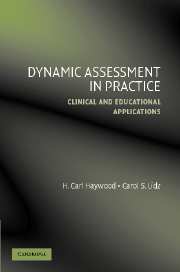Book contents
- Frontmatter
- Contents
- Preface
- Foreword, by Kenneth A. Dodge
- Foreword, by Thomas Oakland
- PART ONE THEORY AND PRINCIPLES
- PART TWO APPLICATIONS
- 4 Dynamic Assessment in Clinical Settings
- 5 Dynamic Assessment in Educational Settings
- 6 Applying Dynamic Assessment with Young Children
- 7 Applying Dynamic Assessment with School-Age Children
- 8 Applying Dynamic Assessment with Adults and Seniors
- 9 Writing Reports and Developing IEPs and Service Plans with Dynamic Assessment
- 10 Unresolved Issues, Conclusions, and Recommendations
- APPENDIX A TESTS REFERRED TO IN THE TEXT THAT DO NOT BELONG TO THE AUTHORS
- APPENDIX B SOURCES OF DYNAMIC ASSESSMENT MATERIALS
- References
- Author Index
- Subject Index
- Tests and Testing Materials Index
9 - Writing Reports and Developing IEPs and Service Plans with Dynamic Assessment
Published online by Cambridge University Press: 04 December 2009
- Frontmatter
- Contents
- Preface
- Foreword, by Kenneth A. Dodge
- Foreword, by Thomas Oakland
- PART ONE THEORY AND PRINCIPLES
- PART TWO APPLICATIONS
- 4 Dynamic Assessment in Clinical Settings
- 5 Dynamic Assessment in Educational Settings
- 6 Applying Dynamic Assessment with Young Children
- 7 Applying Dynamic Assessment with School-Age Children
- 8 Applying Dynamic Assessment with Adults and Seniors
- 9 Writing Reports and Developing IEPs and Service Plans with Dynamic Assessment
- 10 Unresolved Issues, Conclusions, and Recommendations
- APPENDIX A TESTS REFERRED TO IN THE TEXT THAT DO NOT BELONG TO THE AUTHORS
- APPENDIX B SOURCES OF DYNAMIC ASSESSMENT MATERIALS
- References
- Author Index
- Subject Index
- Tests and Testing Materials Index
Summary
In this chapter, we demonstrate how information from dynamic assessment can be integrated into both clinical and psychoeducational reports, with the ultimate objective of developing Individualized Education (IEPs) and Service Plans. These plans should flow directly from the information revealed throughout the course of the assessment, which, in turn, should flow logically from the referral questions and the approaches used for data gathering. Embedding interaction-based interventions in the assessment, which is at the core of dynamic assessment, should generate reports and plans that appropriately address individual needs and improve individuals' responsiveness to instruction and intervention. This chapter includes samples of both psychoeducational and clinical reports.
REPORTING TO EDUCATORS
Reports written by psychologists have generally not served teachers well. Teachers want specific, instruction-relevant, feasible suggestions. They want ideas for action, and they want the actions to work. Through the process of assessment and reporting, psychologists are expected to be able to pose specific, measurable referral questions, tailor assessment procedures to respond to these questions, integrate information to address these questions, and develop ideas for interventions to respond to these questions, reducing the gap between children's current levels of functioning and areas of need and the system's expectations.
Most recommendations regarding report writing emphasize the need for clarity, readability, and relevance. Clarity is achieved by avoidance of jargon and use of a conversational tone.
- Type
- Chapter
- Information
- Dynamic Assessment in PracticeClinical and Educational Applications, pp. 235 - 320Publisher: Cambridge University PressPrint publication year: 2006



